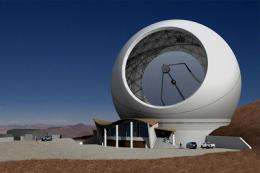Panel recommends support for Chile telescope

A new planned telescope facility in Chile known as CCAT, proposed and led by Cornell scientists, has received strong endorsement from a national panel charged with determining priorities in astronomy and astrophysics for the next decade. The panel of scientists, known as Astro2010, was appointed by the National Academy of Sciences in late 2008 and issued its report Aug. 13.
At 25 meters (82 ft.) in diameter, CCAT would operate at wavelengths shorter than 0.01 of an inch (longer than visible light but shorter than radio waves). Because this requires extremely dry skies, the telescope would be built at 18,400 feet above sea level in the Atacama desert in northern Chile, on the mountain known as Cerro Chajnantor.
One of CCAT's primary assets is a very large field of view, which would enable large-scale surveys of the sky and complement the international Atacama Large Millimeter Array (ALMA), now under construction. As CCAT discovered new sources, ALMA could follow up with images of those sources in unprecedented detail.
"With a broad scientific agenda, CCAT will enable studies of the evolution of galaxies across cosmic time, the formation of clusters of galaxies, the formation of stars in the Milky Way, the formation and evolution of planets, and the nature of objects in the outer solar system," the report notes.
"CCAT is called out to progress promptly to the next step in its development because of its strong science case, its importance to ALMA and its readiness," it continues.
"We've hit a home run," said Riccardo Giovanelli, professor of astronomy and CCAT project director. "CCAT will be a unique telescope at an exceptional site. I am particularly pleased that Astro2010 recommends a quick start for construction, so that all of us, especially in the U.S. community, will have access to its powerful survey capabilities soon after ALMA is fully operational."
To that end, the panel recommended federal support for one-third of the construction cost for CCAT (of an estimated total cost of $110 million); as well as support in the operations phase. Of the projects of medium cost (roughly $50 million to $300 million) reviewed by Astro2010, CCAT was the only project so highly ranked that it was cited in the final report.
Given the strong support, scientists hope to have the telescope in operation by 2017.
The CCAT project concept originated in the late 1990s with the exploration, by Cornell scientists and graduate students, of the astronomical potential of sites in the high deserts of the South American Andes, where the extremely arid climate and high altitude offers a unique opportunity to detect radiation normally blocked to ground-based telescopes by water vapor.
In 2004 the Cornell researchers joined forces with colleagues at the California Institute of Technology to plan and advocate for the project. Since then, additional partners have joined, including the University of Colorado, consortia of German and Canadian universities, and Associated Universities Inc., a not-for-profit Washington, D.C., organization that operates national and international facilities in the United States and Chile, including ALMA.
Provided by Cornell University


















